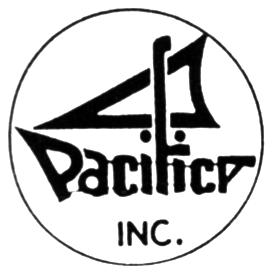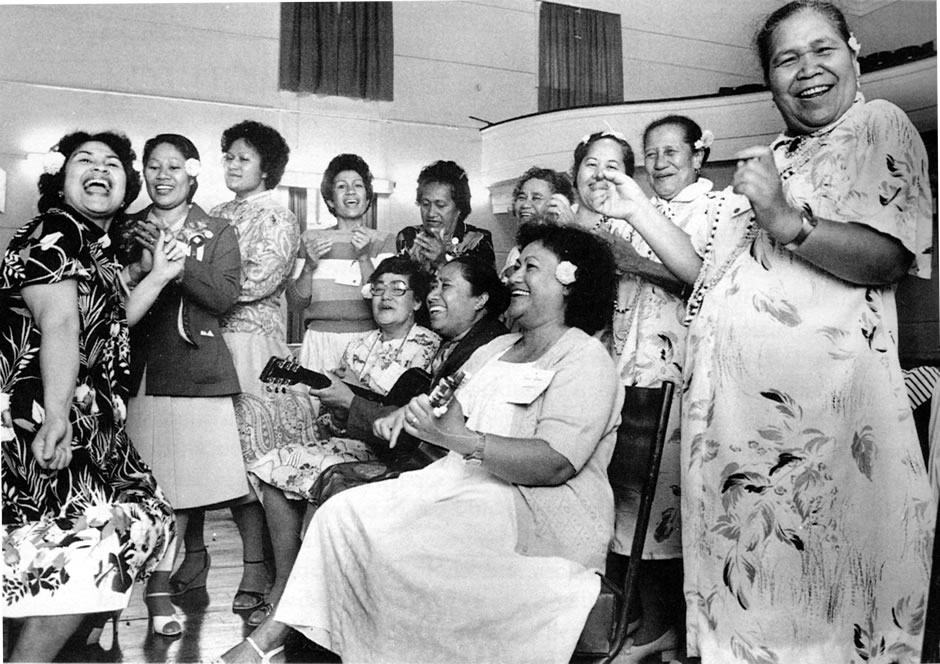
PACIFICA
1975 –
Theme: Immigration and ethnicity
Known as:
- Pacific Women's Council
1975 – 1977 - PACIFICA
1977 –
This essay written by Louisa Crawley and Poko Morgan was first published in Women Together: a History of Women's Organisations in New Zealand in 1993. It was updated by Peggy Dunlop, Bernadette Pereira and Diane Mara in 2018.
1975 – 1993
PACIFICA was established by Pacific women living in New Zealand so that they could speak with one voice and be recognised as a force working for a more positive involvement of Pacific people in New Zealand society.
International Women's Year, 1975, gave Pacific women a rare opportunity to articulate their desire to unite. Led by Paddy Walker, with much encouragement from Mira (later Dame Mira) Szaszy, the women of the Pan-Pacific and South-East Asia Women's Association (PPSEAWA), and others, sixteen women of different Pacific Island group backgrounds came together in Auckland to find ways and means to further their aims. They organised a national conference, the first of its kind for Pacific women, at the University of Auckland in 1976, and over 400 women came. As key organiser, Paddy Walker inspired them to pursue the vision of a united body which would empower Pacific women, enable them to address the common issues and challenges facing them and their families more effectively, and bridge the gap between what was necessary and what was possible.
From these small beginnings there developed an organisation known at first as the Pacific Women's Council. The second national conference, held at Victoria University of Wellington in February 1977, ratified a constitution, elected the first national executive with Walker as president (1977–1980), and accepted the name PACIFICA. [1]
In 1979, Māori and Pacific women met to discuss opportunities and directions for women of Polynesia living in New Zealand. Support and encouragement from Dame Mira Szaszy and the Māori Women's Welfare League continued, and the national presidents of the two organisations attended each other's annual conferences. PACIFICA also affiliated to the National Council of Women (NCW) at national level.
By 1980, PACIFICA had 28 branches, and several Young PACIFICA branches were developing. Members were taking part in government committees and local government, school boards and university women's seminars, festival programmes and community arts councils. A 1980 conference report stated that since the organisation's inception, members had been involved in so many programmes that there were 'very few things going on in New Zealand today to do with women in particular and people in general where we are not playing a part'. Louisa Crawley became president in 1981; when she was appointed Deputy Director of the Ministry of Pacific Island Affairs in 1985, Eti Laufiso took over as president (1985–88), followed by Poko Morgan (1989–92).

Alexander Turnbull Library, EP/1983/0686.
First day of PACIFICA’s eighth annual conference, Wellington, February 1983. Standing from left: Celia Leota, Lifa Mulitalo, Ailini Williams, Tualapu Oliver, Ola Toimata, Tini Crombie, Ina Hellyer, Reura Karana, Tutai Tuaine. Seated: Mellie Likio, Simatale Umaga, Emma Kesha.
In 1992 PACIFICA had about 1000 members in 33 branches. In line with its focus on empowering women, it held innumerable workshops and seminars on education, health, social services, justice, business management, the arts, recreation and employment issues. These forums increased the awareness and participation of Pacific women both within their own communities and in the affairs of the wider community. In 1990, for example, three members were elected to local bodies, one became deputy mayor of Porirua, and several members received commemorative 1990 medals honouring their contribution to New Zealand life. The organisation's first overseas venture, a seminar in Rarotonga, took place in June 1991, with a very positive response from Rarotongan women.
In 1979, the PACIFICA Educational Trust Fund was set up; by 1980 members had raised enough money to award 119 bursaries. Administered and subsidised dollar for dollar by the Pacific Islands Polynesian Education Foundation (PIPEF), with two members of PACIFICA on the allocation committee, these bursaries gave many students the necessary encouragement to complete their secondary education and continue on to tertiary institutions.
PACIFICA promoted the languages of the Pacific as well as sound knowledge of English. At a national convention on early childhood education in 1983, where Poko Morgan led a workshop on Pacific perspectives, the decision was made to lobby for and promote more Pacific preschools. In 1986, the Department of Education put a proposal to the Bernard van Leer Foundation, requesting support for a home-based intervention programme in early childhood education for Pacific communities in New Zealand. This led to the Anau Ako Pacific project, a joint venture involving the foundation, the department, PIPEF and PACIFICA (though PIPEF later withdrew). In 1989, in partnership with the New Zealand Childcare Association, PACIFICA launched a training programme for supervisors of language nests. By 1993 over 70 women had graduated, 50 more were being trained, and about 120 preschools were operating.
In the early 1990s PACIFICA women had their dreams for a happy future for their families, and they intended working hard towards this goal.
Louisa Crawley and Poko Morgan
1994–2018
In the early 1990s, PACIFICA was riding an exhilarating wave, with 45 branches, a national office based in Wellington, and the ability to recruit a project co-ordinator for Community Employment Group training. Pacific women had also learnt the pathways to political participation (and that politics was not simply a male domain, as in the homelands). Clear evidence for this came in the 1999 election, when Luamanuvao Winnie Laban became New Zealand’s first Pacific woman MP. Notably, Luamanuvao was the daughter of a pioneer PACIFICA stalwart, and PACIFICA members had proudly supported her campaign. Luamanuvao successful contested the Mana electorate in the 2002 election, serving as MP for Mana until 2010. Five other Pacific women MPs were later elected, each with strong links with PACIFICA: Le'aufa'amulia Asenati Lole-Taylor, Carmel Sepuloni, Poto Williams, Jenny Salesa, and Anahila Kanongata’a-Suisuiki. PACIFICA members were also winning seats on city councils and hospital boards; most importantly, they were taking Pacific and family issues into these forums.
Educational scholarships for women and girls continued to be a PACIFICA priority. A PACIFICA Restart Tertiary Grant was introduced alongside the PACIFICA Secondary School Scholarship, with the aim of supporting young mothers and elder mamas undertaking studies to improve the wellbeing of their families. Branches from the three regions pledged $10k each to the Tertiary Grant, and vigorous fundraising saw the target of $30,000 achieved in 2012. The Lower Hutt City Council also agreed to an annual PACIFICA Scholarship for the Wellington region (although unfortunately other city councils did not follow this lead).
PACIFICA also began to participate more on the the national and international gender equity scene. In 2005 a PACIFICA delegation attended the Janus Women’s Conference, where the Christchurch Branch launched their publication Mama Rules: Pacific Women Leaders, a resource that was still being widely used in 2018. In 2007, national president Diane Mara went to the 51st United Nations Commission on the Status of Women (CSW) in New York, where she attended both the governmental and NGO conferences. In July 2007, together with delegates from the Maori Women’s Welfare League and Shakti, she attended the Expert Panel session at which New Zealand reported on its performance in relation to the UN Convention on the Elimination of All Forms of Discrimination against Women (CEDAW), and she also heard the reports from other Pacific countries.
Somewhat paradoxically, while these gains for PACIFICA representation in the public domain were being achieved, membership was declining. Undoubtedly this was associated with increasing economic pressures, which led to many Pacific women working long hours to support family needs; increased competition for NGO funding; and an ageing membership. By the late 1990s the number of PACIFICA branches operating had ebbed to between 15 and 20.
These years also saw the emergence of strong and knowledgeable sector groups in which Pacific women were deeply involved. These included Pacific nurses’ associations, Pacific principals’ and teachers’ associations, Pacific business women’s groups, and Pacific early childhood education groups. When the national president Tagaloatele Peggy Dunlop joined AUT in 2009 as New Zealand’s first Professor of Pacific Studies, a new PACIFICA branch was immediately opened at the AUT South Campus. New branches were later opened at two other campus sites, Whitireia (Porirua) and Unitech (West Auckland). This proved to be a successful and fresh new strategy for PACIFICA. By 2018, membership had started climbing again to just over 300 (not including the number of youth members), spread over 17 branches.
The year 2016 was a time for rethinking the 1977 Vision, Aims and Constitution. Led by national president Tofilau Bernadette Pereira, PACIFICA embarked on widespread consultation to identity PACIFICA’s contemporary place and role, and also its strengths and weaknesses for this task. Anecdotal reports suggested that a significant number of Pacific women and girls believed PACIFICA had become out of step with the realities of life for Pacific women and families today. While the old challenges facing Pacific peoples remained (e.g. the relationship of increased educational achievement with better paying jobs and job security, as well as good health), high levels of risk behaviour, especially among Pacific youth, and of family violence were adding new challenges to the security and support systems that Pacific families once enjoyed.
In 2018, PACIFICA’s new vision was ‘Strong women, strong families, strong communities’, plus a focus on youth and passing the baton on. Discussions aimed at devising a strategy to progress this vision brought a growing understanding that one NGO ‘cannot do everything’. Questions arose of whether it was timely for PACIFICA to adopt an ‘umbrella’ role (similar to that of the National Council of Women) so that the organisation could draw on and utilise the knowledge and skills present in the professional and sector groups which Pacific women and girls belonged to. This would ensure that PACIFICA truly fulfilled its national advocacy role of knowing, understanding and presenting the experiences of Pacific women, locally, nationally, and internationally.
PACIFICA was also giving priority to upgrading its communications. A communications officer was appointed to manage the websites, and national and branch information was being shared weekly, along with national and international news and ideas. These postings were generating high interest in diaspora Pacific communities as well. The first ever PACIFICA ball, where elder members from throughout New Zealand were honoured, was held in Auckland in November 2018.
Peggy Dunlop, Bernadette Pereira and Diane Mara
Notes
[1] The letters of the name PACIFICA stand for Pacific Allied (Women's) Council Inspires Faith in Ideals Concerning All. The name has therefore traditionally been set out as P.A.C.I.F.I.C.A.
Unpublished sources
PACIFICA records, 1983–2018, held by the current secretary

Community contributions